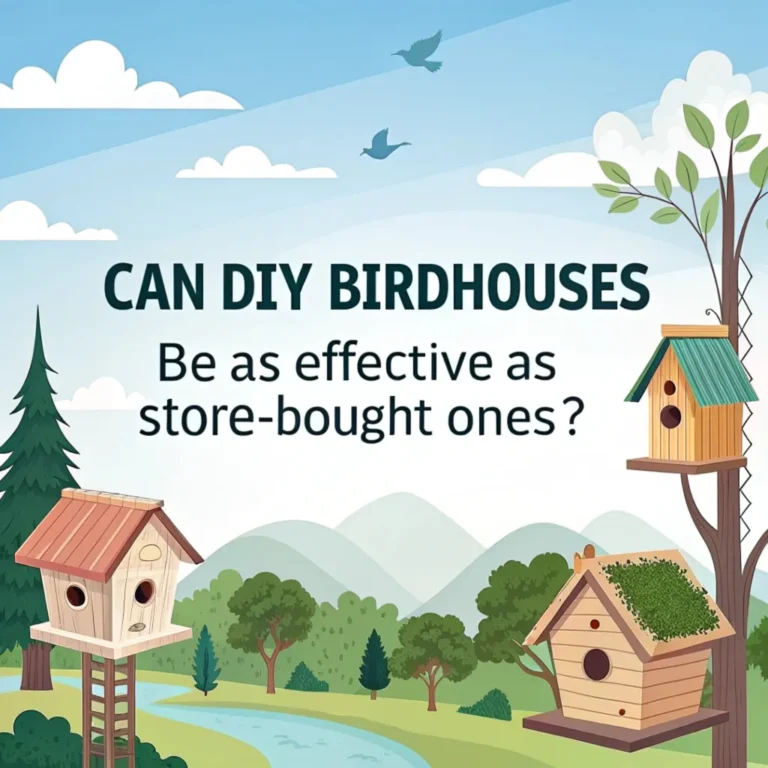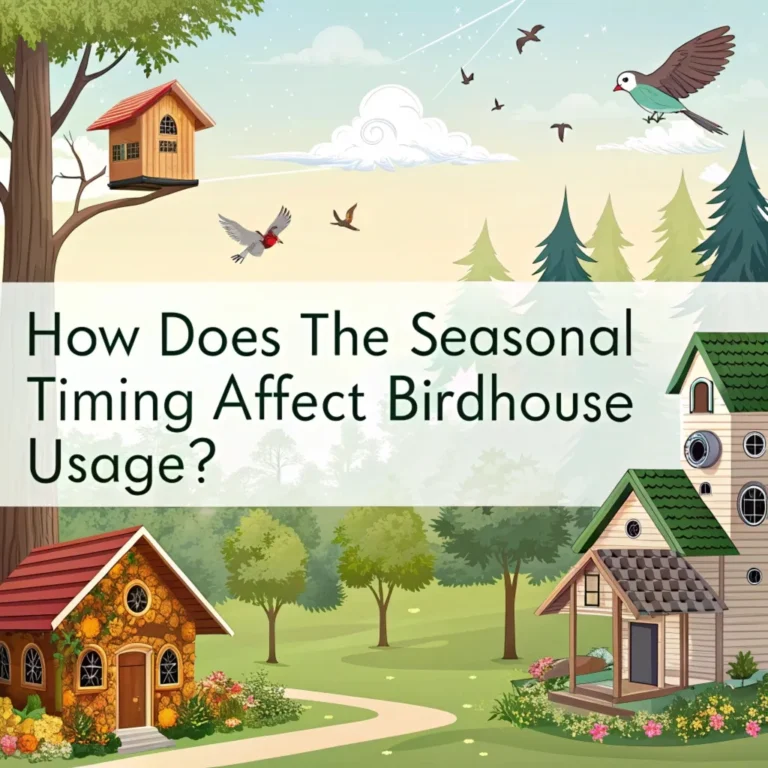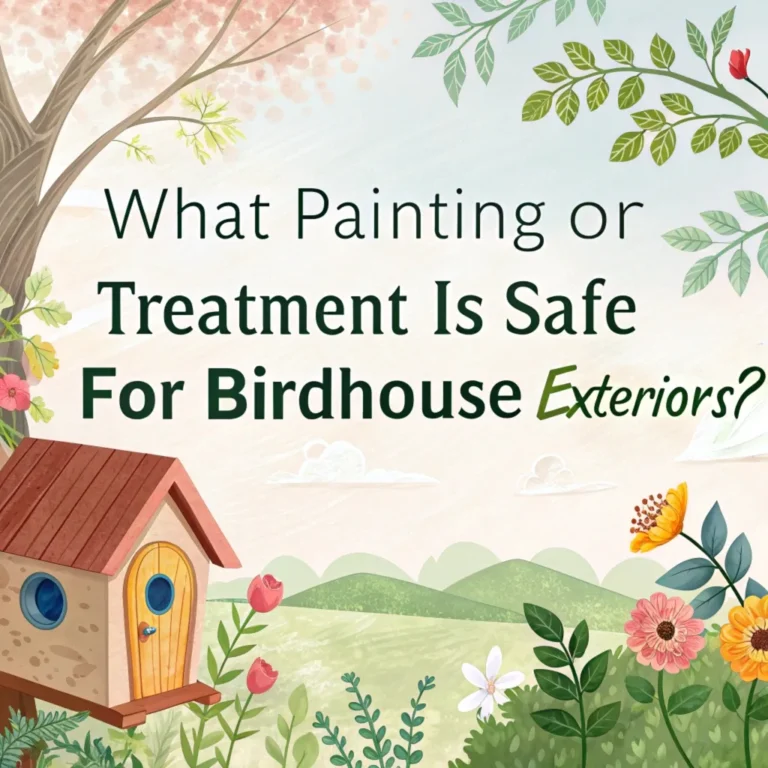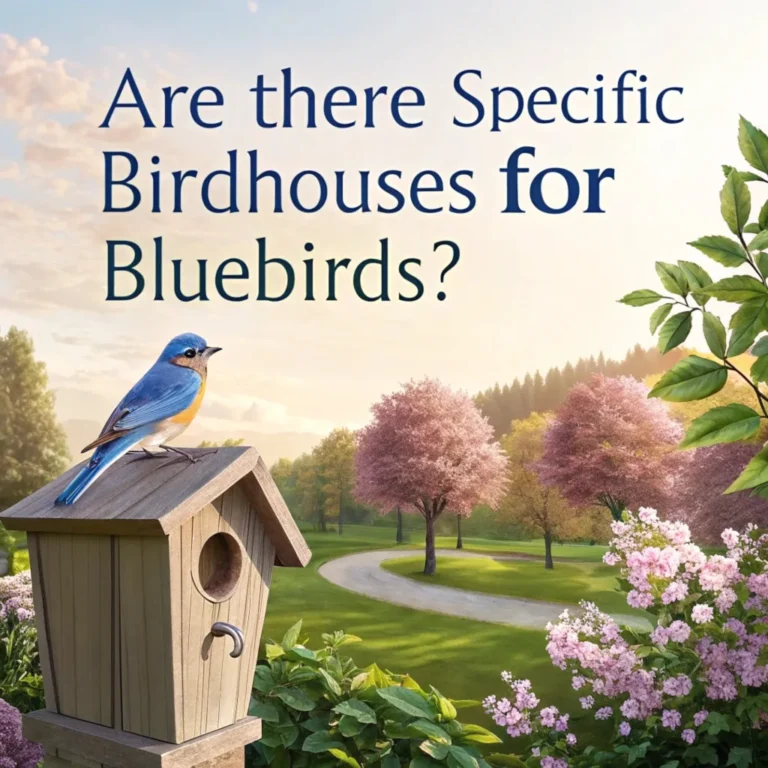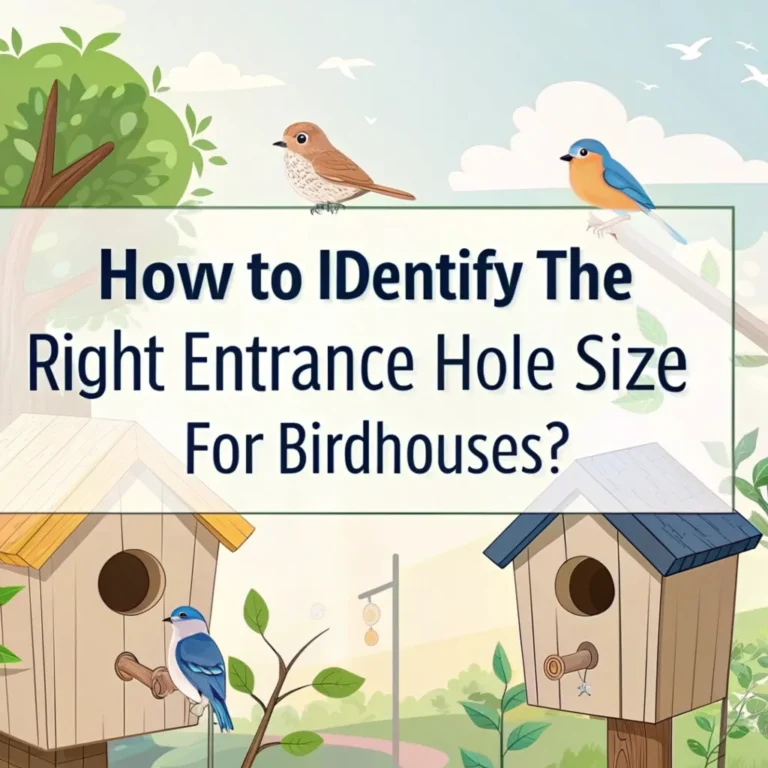How to Monitor and Observe Birds Nesting in Your Birdhouse?
Birds nesting in your birdhouse offer a unique opportunity to witness nature up close.
Proper monitoring techniques ensure the safety of the birds while providing valuable insights into their nesting behavior.
This comprehensive guide will walk you through the best practices for observing birds in your birdhouse without causing disturbance.

Key Takeaways
- Timing is crucial: Monitor nests in the afternoon to avoid disturbing egg-laying or roosting birds.
- Frequency matters: Check nests once every 5-7 days for optimal observation without excessive disturbance.
- Minimize disturbance: Limit nest checks to less than one minute to reduce stress on birds.
- Use appropriate tools: Consider using inspection cameras or mirrors for difficult-to-reach nests.
- Safety first: Avoid checking nests during bad weather or when young birds are close to fledging.
- Be mindful of predators: Take different routes to and from the nest to avoid creating predator trails.
- Record observations: Keep detailed notes of your findings for personal records or citizen science projects.
- Respect wildlife laws: Never handle eggs or birds without proper permits.
- Prepare in advance: Install nest cameras before the breeding season begins for minimal disturbance.
- Clean and maintain: Regularly clean and repair birdhouses to ensure a safe nesting environment.
Observing birds nesting in your birdhouse can be an exciting and educational experience.
By following proper monitoring techniques, you can gain valuable insights into the fascinating world of avian behavior while ensuring the safety and well-being of your feathered visitors.
This guide will provide you with the essential knowledge and tools needed to become a responsible and effective bird nest observer.
Choosing the Right Monitoring Method
Selecting an appropriate monitoring method is essential for successful bird observation. The choice depends on factors such as the nest location, bird species, and your available resources.
Nest Cameras
Nest cameras offer a non-invasive way to monitor bird activity. These devices provide continuous observation without disturbing the birds. Wireless cameras, like the Blink brand, are particularly useful for birdhouses. Install cameras before the nesting season begins to minimize disturbance.
Physical Monitoring
Physical monitoring involves opening the birdhouse to inspect the nest contents. This method requires care and adherence to strict guidelines to avoid disturbing the birds. Physical checks provide detailed information about nest progress but carry a higher risk of disturbance.
Inspection Cameras
Inspection cameras, also known as borescopes or endoscopes, are useful for checking tall nest boxes or hard-to-reach nests. These tools allow you to view nest contents without opening the box, reducing disturbance to the birds.
Choosing the right monitoring method is crucial for successful bird observation. Each approach has its advantages and limitations, so consider your specific situation and the needs of the birds when making your decision.
Remember that the well-being of the nesting birds should always be your top priority, regardless of the method you choose.
By carefully selecting and implementing the appropriate monitoring technique, you can maximize your learning experience while minimizing any potential negative impact on the birds.
This balanced approach ensures that your birdhouse becomes a safe and productive nesting site for generations of feathered families.
Best Practices for Nest Monitoring

Following these guidelines will help ensure the safety of nesting birds while allowing for effective observation.
Timing Your Visits
Choose the right time for nest checks to minimize disturbance:
- Avoid early mornings: Most birds lay eggs in the morning, so afternoon visits are preferable.
- Skip dusk checks: Birds often return to roost in the evening, making this a poor time for monitoring.
- Avoid incubation periods: Limit checks during the first few days of incubation when birds are most sensitive.
Frequency of Checks
Strike a balance between gathering information and minimizing disturbance:
- Check every 5-7 days: This interval provides enough data without excessive intrusion.
- Adjust for species: Some birds, like bluebirds, tolerate more frequent checks than others.
Duration of Visits
Keep your nest checks brief to reduce stress on the birds:
- Limit checks to one minute: Quick observations minimize the time parents are away from the nest.
- Be prepared: Know what to look for before opening the nest box to speed up the process.
Weather Considerations
Choose appropriate weather conditions for nest checks:
- Avoid bad weather: Postpone checks during cold, damp, or rainy conditions to prevent chilling eggs or nestlings.
- Wait for calm days: Conduct checks on mild, dry days to reduce stress on the birds.
Implementing best practices for nest monitoring is crucial for the well-being of nesting birds. By following these guidelines, you can gather valuable data while minimizing disturbance to the birds and their nesting activities.
Remember that each species may have unique sensitivities, so it’s important to research the specific needs of the birds nesting in your birdhouse.
Consistency in your monitoring approach helps create a reliable dataset over time. This information can be invaluable for tracking trends in bird populations and nesting success rates in your area.
By adhering to these best practices, you contribute to both local conservation efforts and broader scientific understanding of avian ecology.
Tools for Effective Monitoring
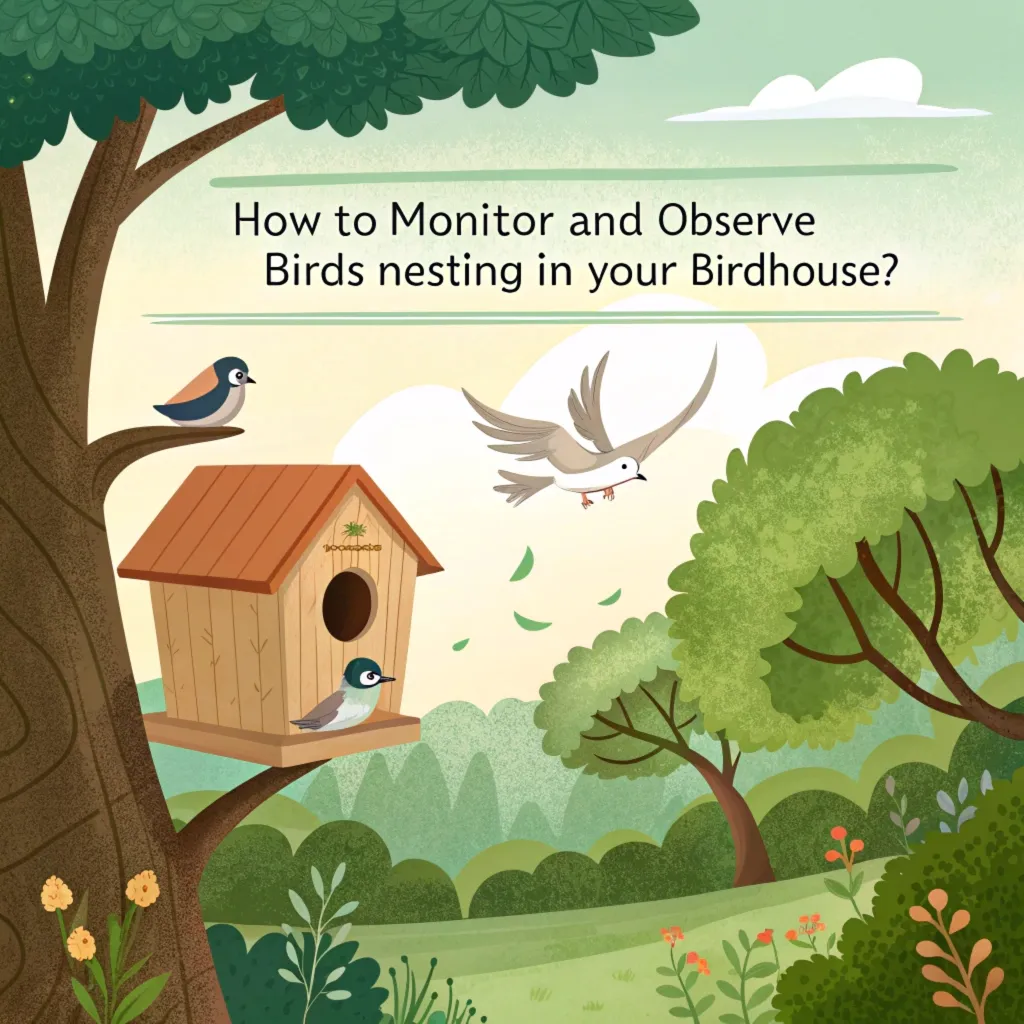
Using the right tools can improve your monitoring efforts while minimizing disturbance to nesting birds.
Nest Cameras
Nest cameras provide continuous, non-invasive monitoring:
- Install early: Set up cameras before the nesting season begins.
- Choose wireless options: Wireless cameras offer flexibility and reduce disturbance.
- Consider night vision: Some cameras provide infrared capabilities for round-the-clock observation.
Inspection Cameras
Inspection cameras allow for nest checks without opening the box:
- Use for tall boxes: These tools are ideal for monitoring nests that are out of reach.
- Practice first: Familiarize yourself with the camera before using it on active nests.
- Take spare batteries: Ensure you have power for extended field use.
Mirrors and Poles
Simple tools can be effective for nest monitoring:
- Use car mechanic mirrors: These can be attached to poles for viewing high nests.
- Create a nest pole: A mirror on a pole can help you see into nests without touching them.
Selecting the right tools for nest monitoring can significantly enhance your ability to observe and collect data without disturbing the birds.
Each tool has its own advantages and applications, so consider your specific monitoring needs and the layout of your birdhouses when choosing equipment.
Remember that the goal is to gather information while minimizing impact on the nesting birds.
As technology advances, new tools for bird monitoring continue to emerge. Staying informed about these innovations in ornithology can help you improve your monitoring techniques over time.
However, even with advanced tools, always prioritize the welfare of the birds and follow ethical guidelines for wildlife observation.
Recording and Reporting Observations
Keeping detailed records of your nest observations is valuable for personal knowledge and citizen science:
- Use a notebook: Record date, time, and observations for each nest check.
- Take photos: Document nest progress with non-invasive photography.
- Participate in projects: Consider contributing your data to citizen science initiatives like NestWatch.
Maintaining Birdhouses
Regular maintenance ensures a safe environment for nesting birds:
- Clean annually: Remove old nests and sanitize boxes after the breeding season.
- Repair damage: Fix any cracks or loose parts to keep the nest dry and secure.
- Check for pests: Remove wasp nests or other unwanted inhabitants before the nesting season.
Proper record-keeping is an essential aspect of responsible bird monitoring. By maintaining detailed and accurate records, you not only enhance your personal understanding of avian behavior but also contribute to broader scientific knowledge.
Your observations, when combined with those of other citizen scientists, can provide valuable insights into bird population trends, nesting success rates, and the impacts of environmental changes.
Regular maintenance of birdhouses is crucial for ensuring the health and safety of nesting birds. A well-maintained birdhouse provides a secure environment for birds to raise their young, increasing the chances of successful fledging.
By incorporating birdhouse maintenance into your routine, you actively contribute to local bird conservation efforts and create a welcoming habitat for future generations of feathered visitors.
Handling Nest Emergencies
Know how to respond to common nest issues:
- Wet nests: If a nest becomes wet, carefully replace it with dry material.
- Pest infestations: Address blow fly or mite infestations promptly to protect nestlings.
- Abandoned eggs: Remove unhatched eggs only if you’re certain they’ve been abandoned.
Legal and Ethical Considerations
Respect wildlife laws and ethical guidelines when monitoring nests:
- Know the laws: It’s illegal to disturb nests of native bird species without permits.
- Avoid handling: Never touch eggs or birds unless you have proper authorization.
- Respect bird behavior: If birds show signs of distress, reduce the frequency of your checks.
Being prepared for nest emergencies is a critical aspect of responsible birdhouse monitoring. While it’s important to minimize interference, there may be situations where intervention is necessary to ensure the survival of nestlings.
Familiarize yourself with common issues and appropriate responses, but always prioritize the well-being of the birds and consult with wildlife experts when in doubt.
Understanding and adhering to legal and ethical guidelines is fundamental to bird monitoring. These regulations are in place to protect birds and their habitats, ensuring that human interactions do not negatively impact their populations.
By following these guidelines, you demonstrate respect for wildlife and contribute to the conservation of bird species. Remember that responsible monitoring practices not only benefit the birds but also enhance the credibility and value of citizen science contributions.
FAQs
How often should I check my birdhouse?
Check your birdhouse once every 5-7 days during the nesting season. This frequency provides enough information without causing excessive disturbance to the birds.
What’s the best time of day to monitor a nest?
The afternoon is the best time to monitor nests. Avoid early mornings when birds are laying eggs and evenings when they’re returning to roost.
Can I touch the eggs or birds in the nest?
No, you should never touch eggs or birds in a nest unless you have proper permits. It’s illegal to disturb native bird nests and can cause parents to abandon their young.
What should I do if I find a dead bird in the nest?
If you find a dead bird, carefully remove it using gloves or a plastic bag. This helps prevent disease and keeps the nest clean for surviving nestlings.
How can I tell if a nest has been abandoned?
A nest may be abandoned if there’s no adult activity for several days. However, consult with a local wildlife expert before taking any action, as some birds may leave the nest for extended periods.
Is it okay to use a nest camera to monitor birds?
Yes, nest cameras are an excellent way to monitor birds without disturbance. Install cameras before the nesting season begins to minimize impact on the birds.
What should I do if I see a predator near the birdhouse?
If you see a predator, do not intervene directly. Instead, consider installing predator guards or repositioning the birdhouse to a safer location for future nesting seasons.
How can I contribute my nest observations to science?
You can contribute your observations to citizen science projects like NestWatch. These programs use data from volunteers to study bird populations and nesting behaviors.
When should I clean out my birdhouse?
Clean out your birdhouse once the nesting season is over, typically in late fall or early winter. This removes old nesting material and prepares the box for the next breeding season.
What if I find a nest of a non-native species like House Sparrows?
Nests of non-native species like House Sparrows can be legally removed. However, ensure correct species identification before taking any action, as disturbing native bird nests is illegal.

Luna is the passionate founder and author of Birds and You, a website dedicated to sharing her love for birds with fellow enthusiasts. Through her engaging articles and guides, she aims to educate and inspire others to explore the fascinating world of birds. When she’s not writing, you can find Luna observing birds in their natural habitats or sharing beautiful bird photography on Pinterest. Join her on this journey to celebrate and protect our feathered friends!



